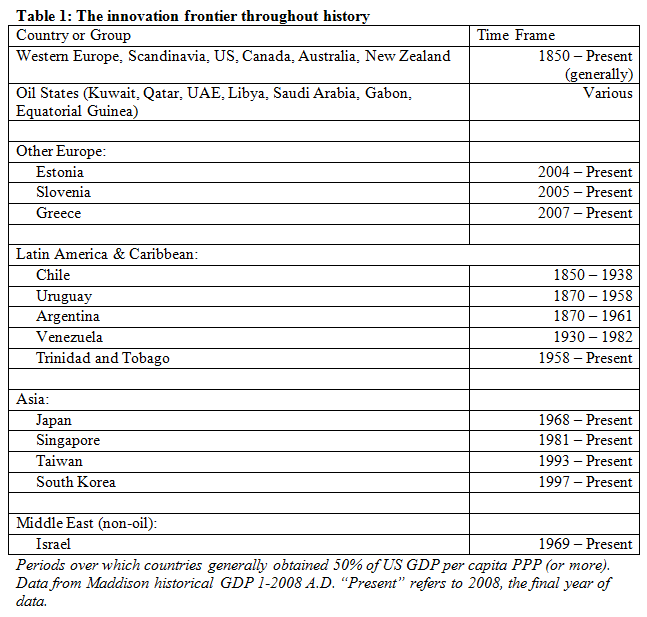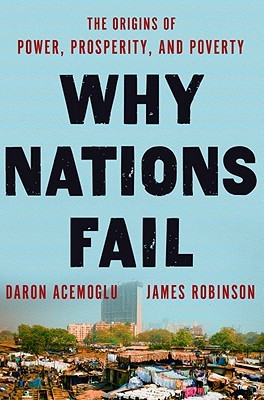Acemoglu and Robinson set forth an authoritative theory of development in Why Nations Fail, but by opting for a general framework they make it difficult to assess claims about specific countries. In the first half of this two part series, I explored their definition of development and concluded that growth alone was insufficient. Successful countries need to attain sustainable growth past an “innovation frontier,” where economic expansion is fuelled by the creative destruction of new ideas.
 Using historical data, it is possible to look more closely at the innovation frontier. To be clear, Acemoglu and Robinson do not explicitly discuss frontiers and thus never specify an exact boundary. However, they have stated that their theory would be harmed should China reach Portugal’s level of development, or around 50% of US GDP per capita PPP. Using that criterion, there has been a small but varied set of nations that reached the frontier (see Table 1). While a majority of the non-oil states are inclusive and democratic, the list also includes countries with more mixed systems like modern Singapore, pre-Peronist Argentina, or Bismarck’s second Reich. A few other less-than-inclusive governments got close, including 1939 military-run Japan (43%) and 1992 South Korea (42%). Why Nations Fail beautifully describes the economic downfall of Peronist Argentina and the political downfall of South Korea’s dictatorship, but it does not address the past 30 years of frontier growth in Singapore and is dismissive of the Latin American countries’ long frontier period. Puzzlingly, their explanation of South Korea’s development is that its economic inclusivity enabled its political transformation, a view that contrasts with their strident criticism of modernisation theory. The most consistent defence of their argument would have required the claim that South Korea’s economy, absent the democratic shift, would have drastically slowed in the mid to late 90’s before it reached the frontier.
Using historical data, it is possible to look more closely at the innovation frontier. To be clear, Acemoglu and Robinson do not explicitly discuss frontiers and thus never specify an exact boundary. However, they have stated that their theory would be harmed should China reach Portugal’s level of development, or around 50% of US GDP per capita PPP. Using that criterion, there has been a small but varied set of nations that reached the frontier (see Table 1). While a majority of the non-oil states are inclusive and democratic, the list also includes countries with more mixed systems like modern Singapore, pre-Peronist Argentina, or Bismarck’s second Reich. A few other less-than-inclusive governments got close, including 1939 military-run Japan (43%) and 1992 South Korea (42%). Why Nations Fail beautifully describes the economic downfall of Peronist Argentina and the political downfall of South Korea’s dictatorship, but it does not address the past 30 years of frontier growth in Singapore and is dismissive of the Latin American countries’ long frontier period. Puzzlingly, their explanation of South Korea’s development is that its economic inclusivity enabled its political transformation, a view that contrasts with their strident criticism of modernisation theory. The most consistent defence of their argument would have required the claim that South Korea’s economy, absent the democratic shift, would have drastically slowed in the mid to late 90’s before it reached the frontier.
These difficulties point to the limits of using a single spectrum to analyse a multidimensional world. Inclusive institutions are undoubtedly important: Acemoglu and Robinson tell many compelling stories about how pluralistic governments embraced, or were forced to embrace, change and innovation that sparked broad-based growth. Their work has an equal number of compelling stories in which authoritarian governments quashed such developments, fearing for a static order that allowed them to extract an economy’s wealth. However, inclusiveness can only explain so much. Acemoglu and Robinson do an effective job of dismissing the simplest versions of some competing theories, but this hardly means we should disregard all other factors.
 Take disease, for instance. Why Nations Fail notes that disease has a political aspect, since effective governments have many tools with which to combat dangerous pathogens, but this relationship is not particularly clean. HIV infection rates in Africa show little relation to the strength of democracy (democracy is not quite equivalent to “inclusiveness,” of course. However, absent a clearer definition of “inclusive,” we can only use imperfect proxies. Other measures, like the WGI governance indicators, give similar results), and government responses to the epidemic have been a mixed bag (see Figure 1). Botswana has a well-funded anti-HIV program while South Africa’s Thabo Mbeki helped inspire a denialist movement; both have some of the highest infection rates in the world. Meanwhile, the inclusive West and repressive Saudi Arabia end up in the strange grouping of comparatively HIV-free nations. As Acemoglu and Robinson have argued, medicine is not enough: a cure for HIV/AIDS is not a cure for poverty. However, it would be mistaken to suggest that eliminating the disease would not help. “Geographic” factors may matter also indirectly, for example as one influence among many on state-building. Acemoglu and Robinson do not address this channel, often portraying politics as more of a black box.
Take disease, for instance. Why Nations Fail notes that disease has a political aspect, since effective governments have many tools with which to combat dangerous pathogens, but this relationship is not particularly clean. HIV infection rates in Africa show little relation to the strength of democracy (democracy is not quite equivalent to “inclusiveness,” of course. However, absent a clearer definition of “inclusive,” we can only use imperfect proxies. Other measures, like the WGI governance indicators, give similar results), and government responses to the epidemic have been a mixed bag (see Figure 1). Botswana has a well-funded anti-HIV program while South Africa’s Thabo Mbeki helped inspire a denialist movement; both have some of the highest infection rates in the world. Meanwhile, the inclusive West and repressive Saudi Arabia end up in the strange grouping of comparatively HIV-free nations. As Acemoglu and Robinson have argued, medicine is not enough: a cure for HIV/AIDS is not a cure for poverty. However, it would be mistaken to suggest that eliminating the disease would not help. “Geographic” factors may matter also indirectly, for example as one influence among many on state-building. Acemoglu and Robinson do not address this channel, often portraying politics as more of a black box.
The authoritarian fear of creative destruction which underpins the Why Nations Fail theory is also not so clear cut. Though essentially all countries were extractive before the 18th century, they incorporated many new technologies over this period. Feudal Europe significantly improved its farming with the three-field system, and medieval monarchs encouraged the spread of powerful ranged weapons like the longbow and gunpowder, which ultimately undermined the chivalric order. More recently, the Chinese Communist Party sanctioned massive layoffs in the 1990’s to increase competitiveness at state-owned enterprises, and the Saudi government not only tolerates but uses Twitter for its own ends. Acemoglu and Robinson give a nod to such events, noting that, all else equal, elites would prefer to increase the size of the economic pie they extract. But extractive governments can allow new technologies for a variety of reasons, including defence, economic competition, and a sense of security.
Why Nations Fail deserves a permanent place in the development canon for reigniting interest in institutions and exploring a compelling terminology to describe their structure. However, the theory it advances is less satisfying as a preeminent paradigm for development. In large part, this is because the theory is less comprehensive in its methods than it is in its geographic and temporal scope. Why Nations Fail tells us what inclusivity is and why it matters, but it falls short as a guide for the complex trajectories of nations that occupy a middle ground between extractive and inclusive. Although Acemoglu and Robinson state that they prefer to avoid “predictive games,” a commitment to a predictive theory would have led to a clearer statement of cause and effect, avoiding some of the ambiguity in the current debate and allowing for clearer tests of their ideas. Such an approach would be highly ambitious but commensurate with their powerful description of economic history. As it is, the coming years will undoubtedly witness additional engaging and productive discussion around Why Nations Fail and the source of the modern world’s vast discrepancies.
This is the second in a two part series. The first half, exploring the definition of development, can be found here. Other perspectives on ‘Why Nations Fail’ can be found here.
Cory Smith is a research assistant at the Brookings Institution in Washington, D.C. You can follow him on Twitter at @developingcory. The views expressed in this piece are solely the views of the author and do not reflect the views of the Brookings Institution.



Leave a Comment